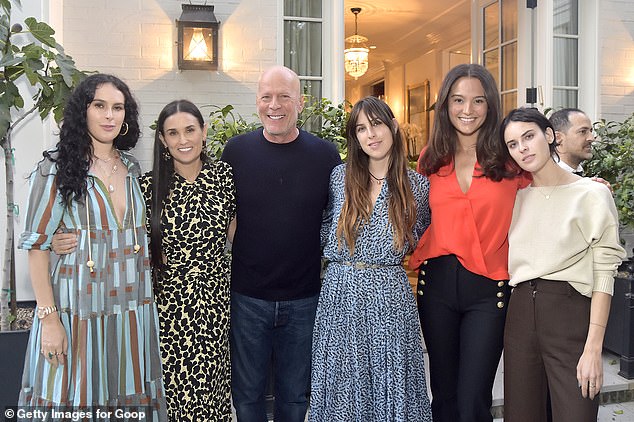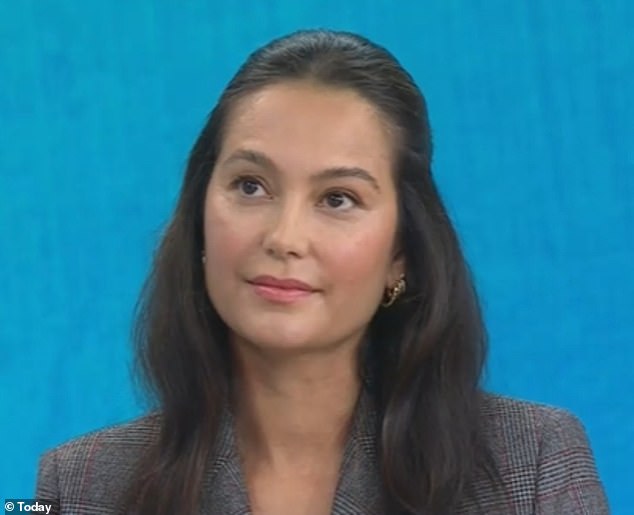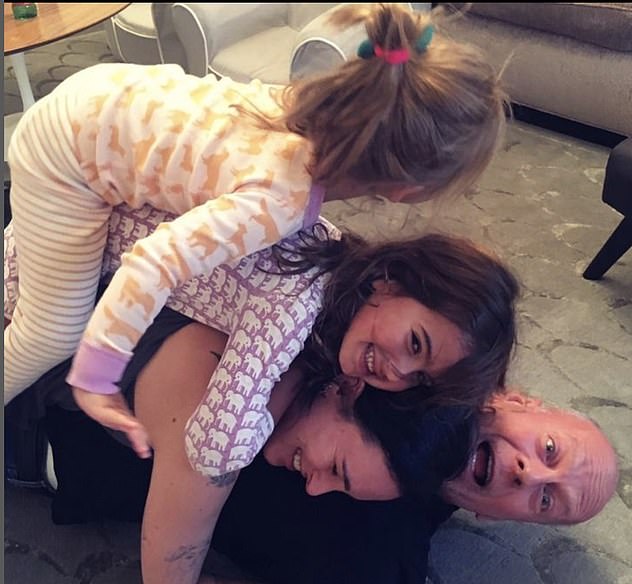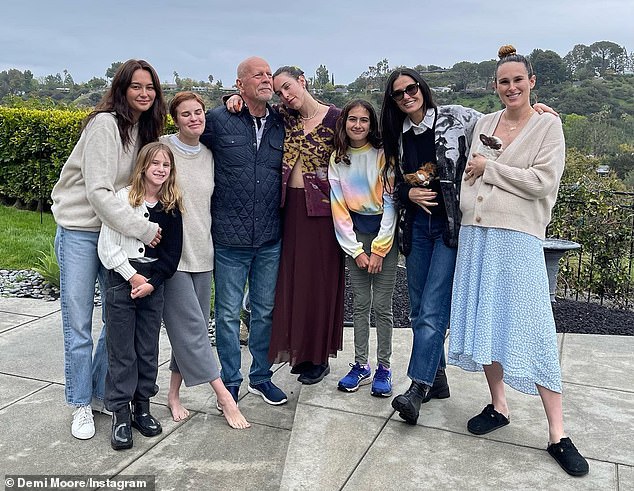Bruce Willis’ daughters Scout and Tallulah pay tribute to their ‘inspirational’ stepmother Emma Heming as she gives a heartbreaking update on actor’s dementia
Bruce Willis’ daughters Scout and Tallulah showed their support for their father’s wife, Emma Heming Willis, after she gave a heartbreaking interview about the actor’s health.
Hollywood icon Bruce, 68, has frontotemporal dementia (FTD) – a rare form of dementia which causes a deterioration of behavior, personality and language.
In the interview, Emma fought back tears as she discussed dealing with the “sadness and sadness” of seeing her husband’s declining health.
Taking to Instagram to reshare a behind-the-scenes clip of Emma’s interview, Scout, 32, Bruce’s eldest child with Demi Moore, wrote: “I honestly couldn’t be more proud of @emmahemingwillis for being willing to step out into the world . public attention (even though it’s scary!!!) to share our family’s story in service of spreading awareness about FTD.
“Emma, you are such a champion for this cause and you inspire me EVERY F*****G DAY with your courage and deep love. Your courage moves mountains #ftd #ftdawareness.”
Inspirational: Bruce Willis ‘daughters’ Scout and Tallulah showed their support for their father’s wife Emma Heming Willis after she gave a heartbreaking interview about the actor’s health

Proud: Scout, 32, took to Instagram to reshare a behind-the-scenes clip of Emma’s interview, writing: ‘I honestly couldn’t be more proud of @emmahemingwillis’

Strong: The youngest of Bruce and Demi’s children Tallulah, 29, posted to her Instagram Stories her older sister’s words with the caption: ‘So proud of my family’
The youngest of Bruce and Demi’s children Tallulah, 29, posted her older sister’s words to her Instagram Stories with the caption: “So proud of my family @emmahemingwillis.”
Bruce married Emma in 2009 and they have two children Mabel Ray Willis, 11, and Evelyn Penn Willis, 9.
The actor has remained good friends with his ex-wife Demi, to whom he was married from 1987 to 2000.
They have three daughters, Scout, Tallulah and Rumer, 35.
In the interview on Monday, Emma said it was something beautiful among the sadness to see their two young daughters caring for their father.
“What I’m learning is that dementia is hard,” she told the Today show. “It’s hard for the person diagnosed. It is also difficult for the family. And that’s no different for Bruce or myself or our girls.
“And when they say this is a family disease, it really is.”
When asked how she explained his illness to their children, she said: “I think it’s always been that way… we’re a very honest and open household.

The whole family: (L-R) Rumer Willis, Demi Moore, Bruce Willis, Scout Willis, Emma Heming Willis and Tallulah Willis in 2019

Emotional: Emma fought back tears during her appearance on Today on Monday morning
‘And the most important thing was that we could say what the disease was, and explain what it is, because when you know what the disease is from a medical point of view, it all makes sense.
“So it was important that we let them know what it is because I don’t want there to be any stigma or shame attached to their father’s diagnosis, or any form of dementia.”
When asked by host Hoda Kotb if he is aware of what is happening to him, Emma paused and revealed, “Hard to know.”
But despite the difficulty of caring for her husband, she said getting a diagnosis has made life “easier.”
“I think it was the blessing and the curse. You know, to finally understand a little bit about what happened, so I can accept what is.
“It doesn’t make it any less painful, but just accepting it and knowing what’s happening to Bruce just makes it a little bit easier.

Doting Dad: Bruce pictured with three of his daughters, including the two he shares with Emma

Family man: Bruce pictured with his entire family, including his ex-wife Demi Moore and their daughters Rumer, Scout and Tallulah
‘So many beautiful things happen in our lives. It’s just really important for me to look up from the grief and sadness so I can see what’s happening around us,” Emma added.
In a particularly touching moment, Hoda asked Emma what she thinks Bruce is teaching their girls as they all come to terms with his illness as a family.
“Honestly, he’s the gift that keeps on giving. Love, patience, resilience, so much…’ Emma said.
“And he teaches me and our whole… I mean, you know, being here doing this is not my comfort zone, but this is Bruce’s strength.”
Hoda continued, “I’ve heard of people who have a sick family member, and I remember this from a friend of mine… she said, ‘My husband’s diagnosis has made my children better people.’ Do you notice that?’
“That’s what strikes me,” Emma replied. “Listen, I think my kids would be great either way! And this is not what I would want for them. But really, like I said, it teaches them so much and how to care and love, and it’s a beautiful thing among the sadness.”
She confirmed that she calls herself Bruce’s “care partner” and not his “caregiver,” and also noted the importance of taking care of oneself as well.
‘It’s so important to ask for help and support. And you can look at organizations like the AFTD, like Hilarity For Charity… it’s a good starting point.
“And it’s important that care partners take care of themselves so they can be the best care partner for the person they care for,” she added.
Emma was joined by Emma Dickinson, the CEO of The Association for Frontotemporal Degeneration (AFTD), who explained: ‘What we know is that the disease can clearly start in the frontal or temporal lobes, as the name suggests.
‘One of the things that the frontal lobe controls is self-insight. We do not know. Some people, that’s the first thing they lose, the realization that they themselves have changed and other people hold on to that for a long time.’
Bruce retired from acting in 2022 as he began his battle with the disease that caused his language skills to deteriorate – and in February 2023, his family confirmed in a joint statement that his condition had made ‘progress’.
The statement read: “Our family wanted to begin by expressing our deepest gratitude for the incredible outpouring of love, support and beautiful stories we have all received since sharing Bruce’s original diagnosis.
“In that spirit, we wanted to give you an update on our beloved husband, father and friend as we now have a better understanding of what he is experiencing.
‘Since we announced Bruce’s aphasia diagnosis in the spring of 2022, Bruce’s condition has progressed and we now have a more specific diagnosis: frontotemporal dementia (known as FTD).
‘Unfortunately, communication difficulties are just one symptom of the illness Bruce is facing. Although this is painful, it is a relief to finally have a clear diagnosis.
‘FTD is a cruel disease that many of us have never heard of and can affect anyone. For people under 60, FTD is the most common form of dementia, and because diagnosis can take years, FTD is likely much more common than we know.”
The Hollywood star, famous for roles in Die Hard, Armageddon and The Fifth Element, had reportedly struggled with cognitive problems on the sets of his films for years before his diagnosis – and even needed an earpiece to give him lines.
